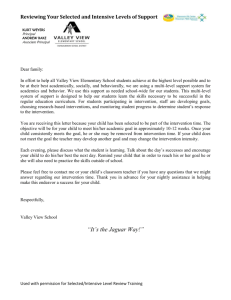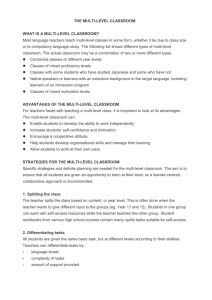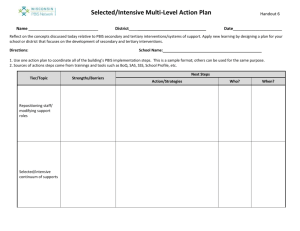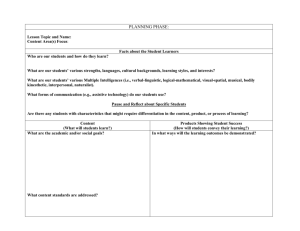Teaching Multi-Level Classes
advertisement
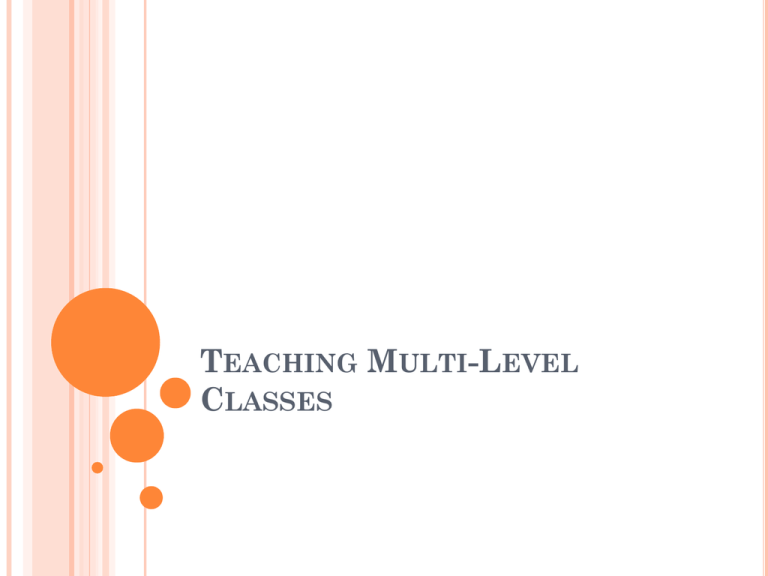
TEACHING MULTI-LEVEL CLASSES FIND SOMEONE WHO… has eaten ice cream this week. ______________________ can speak a language besides English, Russian or Kazakh fluently. ____________________________________ has at least two sisters. ___________________________ can make beshbarmak. ___________________________ drinks at least five cups of tea a day. ______________ cannot swim. ____________________________________. has lived in a country other than Kazakhstan or the U.S. ___________________________________________________ can say the English alphabet backwards within 15 seconds. ___________________________________________ has been to China. _______________________________ owns a cow. ____________________________________ had never been in Almaty before this week. ___________________________________________________. OBJECTIVES OF THE SESSION 1. Define what the term “multi-level classes” means 2. Identify four types of learners in an EFL classroom 3. Brainstorm factors that affect multi-level classes 4. List at least five advantages and disadvantages of a multi-level ESL class 5. Identify at least four strategies for creating activities for multi-level classes 6. Create their own activity for a multi-level class CHARACTERISTICS OF A MULTI-LEVEL ENGLISH AS A FOREIGN LANGUAGE (EFL) CLASS A multi-level classroom is an umbrella term for a multitude of situations. Kazakhstanian classrooms include multi-level classes. There are both strong and weak students. TYPES OF LEARNERS In a multi-level EFL class, there are many types of learners. They include the following types: Learners with no or limited literacy skills in their native language Learners with different EFL proficiency levels Learners who prefer writing to speaking or vice versa Learners with different motivations, interest levels, and educational and cultural background WHAT ARE SOME FACTORS THAT MIGHT INFLUENCE A MULTI-LEVEL CLASS? Different learning styles Gender issues Cultural issues Speed of learning Learning disabilities ADVANTAGES OF A MULTI-LEVEL CLASS Students can use their skills to help each other Students learn at their own speed Teachers can learn to provide more teaching activities and improve their teaching skills. Students don’t have to compete as much because every one is going at his or her own pace. Students learn to be responsible for their own learning strategy and learning behaviors Students develop strong relationships with their peers DISADVANTAGES OF MULTI-LEVEL CLASS Weaker students may feel threatened, left out and/or frustrated Stronger students may feel bored or unchallenged. Teachers must do more work for classroom management and preparation for lessons. Oftentimes, planning is time-consuming and classroom management is exhausting. Teachers must develop or find appropriate materials for every level. Teachers have to be sure that all students are challenged and interested . STRATEGIES FOR MULTI-LEVEL CLASSES What kinds of strategies do you think can work in a multi-level class? What activities have you done in your classes that allow for multi-level classes? STRATEGIES FOR MULTI-LEVEL CLASSES Split the students into groups Teachers split the class based on content. Students in one group can work with self-access resources (e.g., textbooks or workbooks), write a dialogue or complete exercises while the teacher works with the other group. ANIMALS! Volunteers: in pairs, you will write a dialogue about a father and daughter who are visiting the zoo. You must write eight sentences and include at least four animal names. ANIMALS! Counterparts: Please match the animals to the sounds they make. Dog Cockadoodaloo Cat Ribbit! Owl Chomp! Lion Woof woof! Cow AwOOOOOOOO! Sheep Baaa-aa! Mouse Meow! Snake Mooooooo! Rooster Hoot hoot! Alligator Rawr! Frog Squeak! Wolf Hisssssssssss! DIFFERENTIATING TASKS All students are given the same basic task, but at different levels according to their abilities. Teachers can differentiate tasks by Language levels Complexity of the tasks (repetition/copying and/or making up one on their own) Amount of support provided (very controlled or guided in language and content). DIFFERENTIATING TASKS ACTIVITY Volunteers: You must write four sentences in Russian or Kazakh about your favorite hobby. In your sentences, please say how often and where you do this hobby. Counterparts: You must write 7-8 sentences in English about your favorite hobby. You must explain where the origin of your favorite hobby came from. Also, did your parents encourage you to pursue this hobby? Do you have friends who do this hobby now? Would you recommend someone else to pursue this hobby? FOCUSING ON ABILITIES OR SKILLS OTHER THAN LANGUAGE Teachers can motivate even weak students by appealing to the interests and abilities of their students. Math problems, problem solving activities, logic puzzles, riddles, crossword puzzles, memory games and general knowledge questions are just some examples. These activities allow students to participate by using strengths other than language. LOGIC PUZZLE The Toronto zoo has 6 new animals: zebra, elephant, lion, giraffe, hippopotamus, and a monkey. Their names are: Petey, Patricia, Danny, Daisy, Lucy and Larry but not necessarily in that order. 1. The monkey’s name does not start with D. 2. Daisy is not a lion. 3. The giraffe’s name starts with “L”. 4. The zebra’s name does not start with P. 5. Danny is not a hippo. 6. The elephant’s name starts with a P. 7. The hippo’s name does not start with an L. 8. The Lion’s name starts with a P. 9. Larry is not a monkey. 10. The elephant’s name is Petey. GROUP AND PAIR WORK Teachers can put EFL students with similar abilities into groups or pairs. Teachers can also put EFL students who have different levels of English into groups so that the stronger students can help the weaker students. ANY QUESTIONS? YOUR TURN! Now, Volunteers and their Counterparts will create their own activity that would work in a multi-level class.
